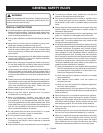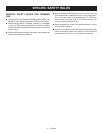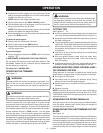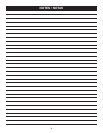
9 — English
OPERATION
Squeeze the throttle trigger fully and pull starter handle
sharply until engine attempts to run. Do not pull the starter
handle more than four (4) times.
NOTE: Keep throttle trigger squeezed fully.
Set the choke lever to the HALF CHOKE position.
Pull the starter grip until the engine runs. Do not pull the
starter grip more than six (6) times.
NOTE: If the engine does not start, return to the full choke
position and repeat the steps that follow.
Allow the engine to run for 10 seconds, then set the choke
lever to the RUN position.
To restart a warm engine:
Slowly press the primer bulb 10 times.
Set the choke lever to the RUN position.
Squeeze the throttle trigger fully and pull the starter handle
until the engine runs.
To stop the engine:
To stop the engine, depress the STOP switch to the stop
position “ ”.
IF ASSISTANCE IS REQUIRED FOR THIS PRODUCT:
Do not return this product to the retail store where it was
purchased. Please call our Customer Service Department
for any issues you may have.
For Help Call: 1-800-860-4050
OPERATING THE TRIMMER
See Figure 11.
WARNING:
Always position the unit on the operator’s right side. The
use of the unit on the operator’s left side will expose
the user to hot surfaces and can result in possible burn
injury.
WARNING:
To avoid burns from hot surfaces, never operate unit with
the bottom of the engine above waist level.
Hold the trimmer with your right hand on the rear handle
and your left hand on the front handle. Keep a firm grip with
both hands while in operation. Trimmer should be held at a
comfortable position with the rear handle about hip height.
Always operate trimmer in RUN position. Cut tall grass
from the top down. This will prevent grass from wrapping
around the shaft housing and string head which could cause
damage from overheating. If grass becomes wrapped around
the string head, STOP THE ENGINE, disconnect the spark
plug wire, and remove the grass. Prolonged cutting at partial
throttle will result in lubricant dripping from the muffler.
WARNING:
Always hold the string trimmer away from the body keep-
ing clearance between the body and the product. Any
contact with the housing or string trimmer cutting head can
result in burns and/or other serious personal injury.
CUTTING TIPS
See Figures 11 - 13.
Avoid hot surfaces by always keeping the tool away from
your body. (Proper operating position shown in figure 11.)
Keep the trimmer tilted toward the area being cut; this is
the best cutting area.
The curved shaft trimmer cuts when passing the unit from
right to left. The straight shaft trimmer cuts when passing
the unit from left to right. This will avoid throwing debris at
the operator. Avoid cutting in the dangerous area shown
in illustration.
Use the tip of line to do the cutting; do not force string
head into uncut grass.
Wire and picket fences cause extra line wear, even
breakage. Stone and brick walls, curbs, and wood may
wear line rapidly.
Avoid trees and shrubs. Tree bark, wood moldings, siding,
and fence posts can easily be damaged by the line.
ADVANCING STRING USING THE REEL-EASY
™
TAP ADVANCE SYSTEM
String advance is controlled by tapping the string head’s
spool retainer on grass while running engine at full throttle.
Run engine at full throttle.
Tap string head on ground to advance string. String
advances each time the head is tapped.
Several taps may be required until string strikes the cut
off blade.
Resume trimming.
NOTE: If the string is worn too short you may not be able to
advance the string by tapping it on the ground. If so, STOP
THE ENGINE, disconnect the spark plug wire, and manually
advance the string.
ADVANCING THE STRING MANUALLY
With the engine off and the spark plug wire disconnected,
push the spool retainer down while pulling on string(s) to
manually advance the string.
GRASS DEFLECTOR LINE TRIMMING CUT-OFF
BLADE
See Figure 14.
The trimmer is equipped with a line trimming cut-off blade on
the grass deflector. For best cutting, advance line until it is
trimmed to length by the cut-off blade. Advance the line when-
ever you hear the engine running faster than normal, or when
trimming efficiency diminishes. This will maintain best perfor-
mance and keep the line long enough to advance properly.


















